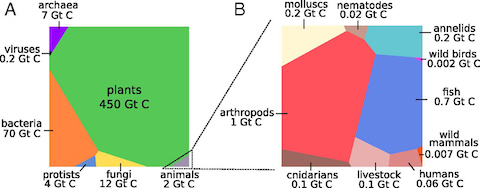
The 2020 Census counts 331 million people living in the USA.
Worldwide there are now almost 8 billion. Which means the United States represents just 4 percent of the total global population.
China and India, with nearly 3 billion people combined, make up about a third of total population.
Researchers also recently calculated a global biomass census to compute the total weight of all things living on Earth.
Biomass is measured in metric tons of carbon because all living things are made of carbon compounds. One gigaton is a billion metric tons.
The weight of all organisms on Earth is estimated at nearly 550 gigatons of carbon.
Plants make up the majority of it at 450 gigatons. They’re more than 80 percent of Earth’s biomass.
Bacteria and fungi together are 80 gigatons, another 15 percent of total biomass.
Animals of all kinds account for just half a percent. Of those, insects and fish are about 1 gigaton each.
And the nearly 8 billion humans? We make up just 6 percent of that—one ten-thousandth of all biomass on Earth.
We’re just one species out of 8.7 million, but we have an outsized impact on nearly every other species, and environment, on Earth. And a responsibility to care for it.
Background
Synopsis: According to the 2020 US census, more than 331 million people reside in the United States. That sounds like a lot of people, but it is only about 4.2% of the 2020 world population of nearly 7.8 billion people. Some researchers estimate that human population may exceed Earth’s ability to support that volume of human life in the next few decades. Ironically, compared to the tremendous biomass Earth supports, humans are just a tiny fraction—one ten-thousandth of the total mass of carbon-based life forms on the planet.
- The 2020 Census establishes a population of 331,449,281 residents as of April 1, 2020, an increase of 7.4% compared to the 2010 census.
- 78% of Americans counted were adults and 22% were children.
- The world population in 2020 was 7.79 billion.
- China and India were the world’s most populous countries with China’s 1.44 billion citizens accounting for 18.3% of world population and India’s residents representing 17.7%.
- The United States is the third most populous country with 4.2% of Earth’s population.
- Indonesia, Pakistan and Brazil follow the United States.
- These six large countries account for 49.4% of Earth’s population.
- Researchers estimate that global population will exceed 8 billion by 2023.
- In 1800, world population reached 1 billion for the first time.
- Researchers estimate it may reach 10 billion by 2055 but wonder if Earth can support that many humans with clean water and food. Human ingenuity and collaboration will be important over the next few decades.
- Earth supports a tremendous amount of biomass—researchers recently undertook a census of the total mass of carbon-based life on the planet and the relative abundances of different types of life forms.
- Biomass is measured in metric tons of carbon because all living creatures are composed of complex compounds of carbon. One gigaton is a billion metric tons.
- The biomass of living organisms on Earth is estimated at 545.8 gigatons of carbon.
- That’s about ten thousand times more than the total biomass of all 7.8 billion humans at 0.06 gigatons (60 million metric tons).
- So, all those humans represent just 0.01% of the carbon-based life on Earth.
- More than 8.7 million different species of organisms currently live on Earth. Humans are just one of those species.
- Plants represent 82.4% of life’s biomass on Earth.
- Bacteria are 12.8% and Fungi are 2.2% of global life-forms.
- Animals are just 0.47% of life on Earth.
- Microscopic viruses represent 3.33 times the mass of Earth’s entire human population.

When it comes to biomass, the 320,000 species of Earth’s living plants carry 7,500 times more carbon than 7.8 million humans do. Credit: The biomass distribution on Earth, Yinon M. Bar-On, Rob Phillips, Ron Milo PNAS
- Human influence on Earth is astounding given our small relative biomass.

